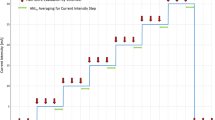Abstract
In a first study with the “Submaximum Effort Tourniquet Technique” mild analgesics were better discriminated from placebo by subjects, demonstrating a calm behavior in the test-situation than by individuals with prominent arousal reactions.
In the present study a tranquilizer-benzoctadiene-was given in order to induce relaxation, with the aim to enhance the subjects ability to discriminate analgesics from placebo.
The homogeneity of the variances (Bartlett-test) were between P 0.1 and 0.05. Therefore an analysis of variance and additionally a non-parametric test (Mann-Whitney U test) were done.
Pain tolerance times in the six groups (placebo, C-44′328-Ba, paracetamol, alone, or in combination with benzoctadiene) on the four pain-levels “slight”, “moderate”, “severe” and “unbearable” were not significantly different when compared by means of analysis of variance.
The comparison of the groups by means of the Mann-Whitney U test showed a) that the combination of the analgesics with benzoctadiene was more effective than either analgesic given alone on three, resp. one of the four pain-levels, b) that in the “Non Benzoctadiene Group” the analgesics were not differentiated from placebo, and c) that within the “Benzoctadiene Group” each analgesic was more effective than placebo on two pain-levels.
Similar content being viewed by others
References
Beecher, H. K.: The measurement of pain. Prototype for the quantitative study of subjective responses. Pharmacol. Rev. 9, 59–209 (1957)
Beecher, H. K.: Some complexities of the pain experiences as seen in comparative studies of pathological and experimental pain. Res. Publ. Ass. nerv. ment. Dis. 46, 157–165 (1968)
Benjamin, F. B.: Effects of aspirin on suprathreshold pain in man. Science 128, 303–304 (1958)
Ferguson, R. K.: Drug-test interaction in the submaximum effort tourniquet technique. Proc. Soc. exp. Biol. (N.Y.) 134, 1015–1019 (1970)
Hill, H., Kornetsky, C., Flanary, H., Wikler, A.: Effects of anxiety and morphine on discrimination of intensities of painful stimuli. J. clin. Invest. 31, 473–480 (1952)
Jovanovic, U. J., Durrigel, V., Rogina, V.: Hirnbioelektrische und testpsychologische Untersuchungen mit Tacitin und Alkohol, pp. 148. Internat. Sympos. St. Moritz, 11.–13. Jan. 1971
Lim, R. K. S.: Pharmacologic viewpoint of pain and analgesia in: New concepts of pain. E. L. Way, Ed., pp. 33–47. Philadelphia: F. A. Davis Co. 1967
Melzack, R.: Pain perception. Res. Publ. Ass. nerv. ment. Dis. 48, 272–285 (1970)
Morgan, W. L., Engel, G. L.: The clinical approach to the patient. Philadelphia-London-Toronto: W. B. Saunders 1969
Smith, G. M., Egbert, L. D., Markowitz, R. A., Mosteller, F., Beecher, H. K.: An experimental pain method sensitive to morphine in man: The submaximum effort tourniquet technique. J. Pharmacol. exp. Ther. 154, 324–332 (1966)
Smith, G. M., Beecher, H. K.: Experimental production of pain in man: Sensitivity of a new method to 600 mg Aspirin. Clin. Pharmacol. Ther. 10, 213–216 (1969)
Author information
Authors and Affiliations
Rights and permissions
About this article
Cite this article
Adler, R., Gervasi, A., Holzer, B. et al. Mild analgesics evaluated with the “Submaximum Effort Tourniquet Technique”. Psychopharmacologia 38, 357–362 (1974). https://doi.org/10.1007/BF00429134
Received:
Issue Date:
DOI: https://doi.org/10.1007/BF00429134




